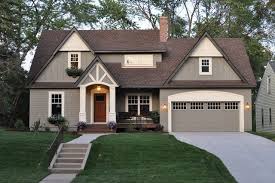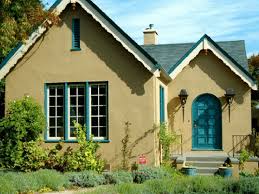How do I choose a trim color?
If you’ve ever wondered what color to paint the molding and trim, you may automatically say trim is always white. But do moldings have to be white? No rule says that it has to be that way. But remember that white trim can act as a thread to tie together different colored rooms, because it keeps the eye moving through the space.
However, for the low ceilings in contemporary rooms, painting the trim the same color as the walls (or a shade or tint that’s close) is usually better. This trick keeps the walls from being visually chopped up and makes the ceiling look higher. If you want your eye to travel to the trim or if your house needs a unifying thread, consider using white molding. Otherwise, match the color of your walls.
If you do decide on white trim and moldings, you might be surprised at how many shades of white are available. Choosing one can be maddening. If your rooms are painted different colors (for example: red dining room, yellow kitchen, sage green family room), choose a shade that will complement each color. If that’s difficult to do, then choose one based on the room where you spend the most time.

Here are some easy ways to do it:
- Blend or contrast as you see fit. One of the first things you should decide on is whether you want your trim color to blend with your interiors’ current scheme, or switch things up by picking contrasting hues. This makes deciding which colors to go for even easier.
- Pick a trim that’s the same shade as the walls. It offers a modern look and a soothing feel. Since it’s the same hue as the room, the artwork on the walls and more colorful items pop out more.
- Play it safe with white colors. White trim is a tried-and-true way to set off the look of your interiors. In fact, white makes everything look good when you use it effectively. For instance, it makes your double hung window in Waukesha look cleaner and neater if the room it’s in features softer colors. Walls with bolder colors will benefit from white trim, as well. It accentuates the striking hues in the room while providing visual relief. Just be sure to choose the right shade of white for this. There are choices available that offer a warmer or cooler look to your interiors. Warm, creamy-white trim works better with striking wall colors. Cooler white trim, on the other hand, is perfect for walls with muted or saturated colors.
- Go for black. A trim darker than the adjacent walls can easily serve as the focal point of your home. Black, in particular, is an elegant and brooding color. It works exceptionally well when your walls have paler hues, since it emphasizes the interesting contrast between dark and light. Renewal by Andersen of Milwaukee, for instance, offers black-trimmed replacement windows in Waukesha that you can pair off-white or cream walls. This adds warmth to your home’s interiors. Of course, you’ll need to consider the size of the room for this. Black trim suits larger spaces better.

Best Colors for Bathrooms
Because bathrooms are high moisture areas, the best bathroom paint colors tend to be lighter ones. Light colors tend to work better at hiding any accumulated moisture on the wall. Another clever way to hide moisture is by choosing a paint with a glossier finish. While satin and eggshell are the most common finishes in other areas of the house, you may want to use a semi-gloss in the bathroom. No matter what type of color you choose, you may want to invest in mildew-resistant paint. The extra money may be worth it to help avoid those steamy streaks running down your bathroom walls.
Best Colors for Dark Rooms
If you need to bring the sun into a dark room, what better choice than yellow? You can infuse a room with warmth and light even on a dreary day with this friendly color. For the color-shy, a light yellow, or white with yellow undertones would work wonders in an otherwise dingy room. For the color-confident, consider going sunny-side up with more vivid variations of this lively hue. Even the more subdued versions of this color lend a cheery outlook to any room. Yellow can’t help but look bright side of life.

Best Colors for Trim and Woodwork
While white is the obvious choice for trim color, choosing the perfect white trim color can be daunting. There are hundreds of shades of white paint, believe it or not. Again, you need to look at the undertones. White paint colors can have as many undertones as there are colors so look carefully. Compare the swatches to your existing colors. Bright white trim colors can anchor a high contrast, vibrant feel. Creamy or off-white paint lends a more antique, warm feel.
While white is most common, it certainly isn’t your only option for trim. To add a modern feel to the sometimes-overwhelming feel of wood wainscoting and trim, you can paint the walls and trim the same color. You create the illusion of a larger space, while maintaining the texture and depth of the woodwork. The effect is particularly punchy when used with a vibrant hue.
Want a classic look with a little bit of edge: go black. Black is the perfect contrast to subtle neutrals. Black doors also pair well with white trim. The classic combination dresses up any decor. Like whites, you’ll have several black options from which to choose. Again, pay attention to the undertone and the intensity of the color. More muted blacks can give you a sharp look without overwhelming a space.
Painting Your Trim White
White trim is by far the most popular choice amongst home owners as it can give any room a classic look that matches practically everything. Whether you have bright, soft, or pastel walls, white trim paint will work to create subtle contrast. And if your wall paint is bold or intense, white trim can bring a lighter look to the room. If you simply can’t decide on the perfect color for your trim, white is always a great fallback that won’t let you down. White on trim is timeless.
Painting Trim and Walls the Same Color
When choosing paint trim color for a small space, consider a color that is the same hue as your walls. Not only will this technique make the room appear larger, but it will also give it a modern look and the feeling of a more unified space. Be sure to choose a glossier finish for your trim so when the light hits, the trim can still stand out while up against walls of the same color.
Painting Trim Darker Than Walls
If you want to create a contrasted look or bring focus to your windows or door frames, choosing a trim paint color that is darker than the walls of a room can be an ideal choice. Try a dark hued paint that is several shades darker than your wall paint to create a sense of depth. Or if you have an older home, consider having professional painters paint woodwork in a dark mahogany or black-brown to bring out the intricate details.